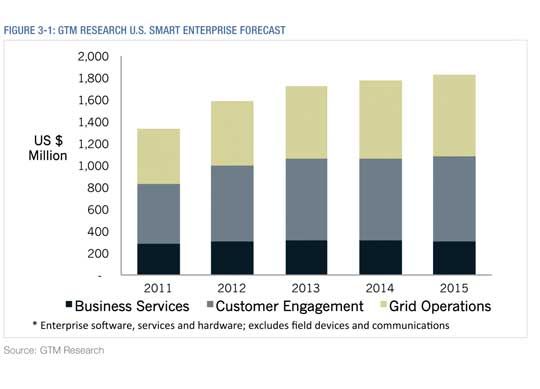In recent years, smart meters have garnered most of the headlines, and investment, when it comes to the smart grid. But beyond metering and distribution hardware, there is a need for upgrades in information and operations technology to connect and crunch all of the data coming off of the 21st century hardware.
In a new in-depth report from GTM Research, The Smart Utility Enterprise 2011-2015, Senior GTM Analyst Chet Geschickter forecasts that utilities in the U.S. will spend $8.25 billion between 2011 to 2015 in three major areas: customer engagement, business services and grid operations.

That spending will allow for many of the advantages that smart grid can deliver, from more tailored pricing offerings for the average consumer to more coordinated outage response. In fact, grid operations and customer engagement will make up the bulk of the spending, with business services coming in third.
The operations category includes outage management systems, geographic information systems and distribution automation, which is no surprise, as DA is the fastest-growing smart grid market segment, according to GTM Research. Other upgrades, like wide-area situation awareness using synchrophasors, have been ongoing for sometime (thanks in part to the 2003 blackout) and continue to see sizeable investment. GTM Research estimates that about one-third of spending on synchrophasor projects will go to software and operations center spending.
In the customer engagement sphere, the cash being spent on enterprise will go to customer web portals, upgrades or replacements of customer information systems, and home area network enablement. Services and products for meter data management are another hot category, with MDMS to head-end systems integration a significant cost driver, according to the report.
Says Geschickter, "Utilities deploying AMI and eyeing new pricing plans face significant challenges with their legacy customer information and billing systems. These systems are hard to modify and complex to replace. We expect many AMI leaders will spend heavily in these areas." Distribution automation is another hotspot as well. "We also expect lots of activity in the operations side of the enterprise as utilities rush to put the systems in place to gather and analyze data from intelligent electronic devices and rollout new applications like grid optimization and self-healing."
After backlash in different forms taking place in locations from Bakersfield to the Netherlands, customer engagement and education -- starting with web portals and access to data -- has become the calling card of the industry.
According to the report, billions will flow into consumer marketing and education during the forecast timeframe, as well.
Less sexy (depending on your definition of sexy) than winning and keeping customers is business services. Utilities have historically underinvested in IT, but smart grid stimulus funds have meant that many utilities need to ramp up -- and fast. Geshickter says the situation is analogous to a snake eating a rat, and as the lump of that money works its way through the industry snake, it will even back out over time as utilities change their mix of personnel to meet their new business needs. According to Geschickter, "As IT management moves from grant writing to implementation, they need strategic planning help to develop a smart grid roadmap and organization change management plans; they need project management services to manage the increase in project activity; and they need short-term staff augmentation to fix inaccurate data and conduct system testing. 'Garbage in, garbage out' still applies."
In addition to the market forecast, the report provides in-depth analysis of the market drivers for the smart enterprise, coverage of a broad range of enterprise technologies including utility applications and service oriented architecture (SOA) middleware, and profiles of more than 30 leading smart enterprise vendors, ranging from behemoths like IBM, ABB, GE, Oracle and Siemens to innovative startups like Space Time Insight and Calico Energy. Leading system integrators and specialty consultancies are also covered.
For more details about smart utility enterprise systems, check out the full report from GTM Research, The Smart Utility Enterprise 2011-2015.



